AVENGING SPIDER-MAN #7 (Marvel Comics, $3.99)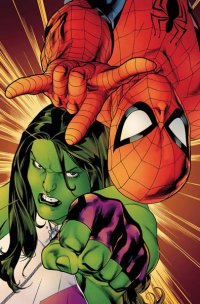
By Devon Sanders
If you’re a 70’s/80’s baby like myself, you’re familiar with the “backdoor pilot”. (tee-hee)
The backdoor pilot was a staple of 70’s/80’s television where and already established show, such as “Diff’rent Strokes”, would introduce and/or hotshot a new series such as “The Facts of Life” onto a potential viewing audience. I never ask for much. I’ve not yet figured out how to domesticate a panther. Rosario Dawson is not sitting on my lap as I type this.
Please, Marvel; if Avenging Spider-Man #7, written by Kathryn Immonen and drawn by Stuart Immonen, is being used as a backdoor pilot for a potential She-Hulk series, this empty lap and panther-less life will become just that much more bearable.
Deep within the New York sewer system, She-Hulk and Spider-Man wrestle an angry fish with two arms. That out of the way, She-Hulk must attend the opening of a new Egyptian exhibit the law firm sponsored by her law firm. Always up for a good time, Spidey wants to join in on the fun and… kitty-cats. Kitty cats happen. And gods. Spider-Man wears a bull’s head. She-Hulk grows a tail. And… comics!
Call me crazy but I’m of a mind that you should just be able to enjoy your comics and I’ve enjoyed every Kathryn Immonen-written comic I’ve ever read. Jokes and absurdity are dropped left and right and in She-Hulk, Immonen brilliantly provides Spidey’s natural neutral good, a home in fellow Avenger, She-Hulk. Immonen gets that Spider-Man isn’t necessarily funny; he believes he’s funny and She-Hulk, a character known for breaking the fourth wall, isn’t always in on the joke, making her his perfect compliment.
This is all drawn skillfully by Stuart Immonen. Immonen gets these characters. His She-Hulk is near perfect; an image of athleticism and in manner, somewhat jaded (I went there) while his version of Spider-Man is always doing something. Invading personal space, swinging, hanging upside down for no good reason, cringing, gesticulating. Being annoying. Being Spider-Man.
Upon finishing this issue, I wished for more fun, clever comics like this one. Upon finishing this review, my lap is still empty so… make with the comics, folks.
Rating: 




Out of a Possible 5 Stars
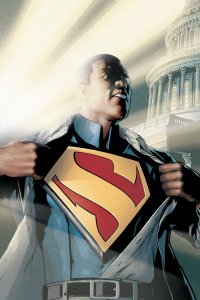 Action Comics #9 (DC, $3.99)
Action Comics #9 (DC, $3.99)
By Adam Prosser
Of late, Grant Morrison has been accused of being a company man, partly because of certain comments (in his book Supergods> and elsewhere) that could be interpreted as dismissive of the struggles creators have faced against huge corporations, and partly because, well, he still works at DC, a company that has increasingly managed to alienate most other writers with anything resembling integrity. In fact, Morrison is in many ways the only real beacon of quality DC can still boast, on the writing side at least, even as the new 52 wreaked havoc with his ongoing Batman, Inc. series, and as his run on Action Comics has seemed tragically limited by the need to reboot Superman’s continuity. While AC has still been a Grant Morrison comic, with its dense pacing, weird ideas and tongue-in-cheek bombastic dialogue, it also shows the marks of an editorial mandate to showcase a “hip young Superman” and retell this story from scratch…AGAIN…which makes the whole thing a lot less thrilling than the concept of the writer of All-Star Superman managing a Superman monthly ought to be.
But Morrison’s always been one to try and squirm out from under whatever limitations are placed on him, so it’s not surprising that AC is already starting to shuck off the limitations of the New 52 and turn into something more interesting. With this issue, Morrison ditches “our” Superman entirely to cast a focus on the parallel worlds of the newly reborn DC multiverse, which is an interesting tack for the “non-Superman Superman” book to take. The hero here is Calvin Ellis, the alternate-Earth Superman introduced in (if I recall correctly) Final Crisis, which right there seems to demonstrate that Morrison doesn’t really care much about the new continuity. Ellis isn’t just Superman, he’s also black and the president of the United States, so you can see how that would be more than enough of a hook to hang the story on…but there’s an even more interesting element in play here.
See, the villain is yet another parallel-Earth Superman, one who’s quite different from any version of Supes we’re familiar with. In this reality, Clark Kent is a regular human being, a scientist and traveller who, with the help of Jimmy Olsen and Lois Lane, builds a machine that channels the principles of Tibetan “tulpas” or thought-forms. They us is to create their own Superman, a “made-up messiah”, literally an idea made flesh, with the hope of making the world a better place. Unfortunately, in their search for funding to make the thought-forms permanent, they turn to a nameless, evil corporation that immediately turns their creation to unpleasant ends—“They built a violent, troubled, faceless <b>anti-hero</b>, concealing a tragic secret life, a global marketing icon.” A Superman who becomes whatever you want it to be, but in a world where “what you want it to be” is shaped relentlessly by the image-makers, resulting in a violent, angst-filled Superman who kills and destroys without a second thought.
Also he wears armour.
The clash between the Ellis Superman and the anti-Superman really can’t be misread as a statement of purpose, and in fact, after reading this book, I’ll honestly be amazed if we don’t hear that Morrison’s leaving DC within the next few months. I mean, I can’t picture even Dan Didio reading this book and not realizing that he’s being savagely critiqued. On top of everything else, Morrison has to go to another reality to find the “real” Superman, the one who stands for goodness and justice and the power of ideas to make the world a better place. Because he ain’t in the DCU anymore.
On the other hand, this comic slipped out last week and seems to have flown under everyone’s radar, so maybe this will go down as one of the all-time examples of a comics writer biting the hand that feeds him an getting away with it. But even if DC is still going to let him get away with this kind of thing, I can’t imagine Morrison wanting to let them for much longer. A better universe awaits.
Rating: 




Out of a Possible 5 Stars
Afrodisiac (AdHouse Books, $14.99)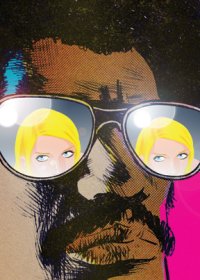
by Graig Kent
One of my most favourite things of the past decade has to be the film Black Dynamite, the 2009 Blackspoitation spoof/satire/homage from Michael Jai White and company. It succeeds in being funny because of its devotion to authenticity, and by playing it straight. There’s genuine love for the exploitation sub-genre from Black Dynamite’s creators, which allows them to both mock and pay tribute to the conventions, embracing what’s funny but also what’s great about the low budget afro-centric features of old.
Similarly Afrodisiac‘s much paler creative team of Jim Rugg and Brian Maruca obviously have a great love for Blacksploitation and all its tropes, as well as comic books and the medium’s own rather narrow take on capitalizing on the sub-genre’s popularity, as well as its early, somewhat painful attempts at diversification. Afrodisiac plays it even straighter than Black Dynamite does, almost abandoning intentional comedy altogether and instead striving to create something that would seem faithful to the spirit and tone of the Blacksploitation heyday, while embracing the ludicrousness of the 70’s “anything goes” attitude.
Akin to Black Dynamite’s first foray into comics last year and Cullen Bunn and Matt Kindt’s note-perfect nostalgic exercise The Tooth, Afrodisiac (predating them both in first printing, I might add, now in its third) is a anachronistic time capsule of sorts, within its pages establishing a 144-issue run of the Afrodisiac series (ending January 1984), and showcasing highlights from throughout. There’s multiple stories of varying length, from Afrodisiac single-handedly stopping a lady-alien invasion from Venus, to an encounter with Hercules at a bar, to a rendez-vous with Death, to a showdown with Dracula. Outside of the stories there’s plenty of bonus covers (a sequence of four highlights the “romance comic” era of Afrodisiac), out-of-context panel excerpts (like a single frame of wrestling-garbed Afrodisiac and Nixon, an unlikely tag-team duo), and a cel from the Afrodisiac animated series.
The character himself is a hybrid of the prototypical Blacksploitation protagonist, part pimp, part private dick, all tough-guy, and the ultimate ladies man. He’s a smooth, hard cat, to be sure. His pimping is on the down-low and only ever inferred, but you know what’s going on. The ladies can’t resist him and he wouldn’t have it any other way. Rugg and Maruca clearly know their source inspirations intimately, and are able to generate an effective, highly charming, and thoroughly entertaining addition to the sub-genre. Rugg’s art, which jockeys about multiple techniques as he replicates the shifting styles that were popular throughout the 70’s and early 80’s, is outstanding. The coloring alone, which fluctuates from dull to vibrant to four-color to monochromatic is an integral part of the sell, and a key part to the book’s effectiveness.
It’s not quite as glee-inducing as Black Dynamite, but then it’s not intending to be a comedy (even though the publisher classified it on the back cover as “Hip Hop/Superhero/Comedy/Art”, really only getting one of those labels correct), and it’s certainly not a competition between them. Though they’re both attempting to create an era-specific Blacksploitation hero (and equally succeeding at doing so) they’re doing so by approaching from different angles, albeit only varying by the slightest of degrees. Despite their outsized egos there’s plenty of room for both of them.
Rating: 




Out of a Possible 5 Stars
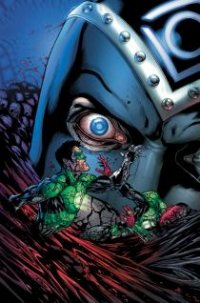 Green Lantern #9 ($2.99, DC)
Green Lantern #9 ($2.99, DC)
by D.S. Randlett
Green Lantern has been something of a punchline recently. As a lifelong fan of the concept, from Hal to Kyle to back again, this has been somewhat frustrating, especially since so much of the non-motion picture (and non video game) material involving power rings and their users have been pretty strong ever since Geoff Johns rebooted the title a few years back. For one, Johns and company pushed the GL franchise into something that felt huge, and cosmic, something that previous runs had failed to manage despite the centrality of outer space to the concept. Johns realized that part of the problem with the concept was that it had been treated as if the superhero genre was at its core rather than its surface. Johns has his faults as a writer, but he has a talent for finding that “core appeal” of superhero characters. With GL, that core paradoxically involved a separation from the superhero milieu.
And as cheesy as it can be, the multi-colored spectrum was something of a stroke of genius. I remember wondering why DC would bother bringing Hal Jordan back besides familiarity and nostalgia. I think I finally got it during the “Agent Orange” storyline. The resurrection of Hal Jordan provided Johns with a convenient redemption narrative, sure, but there was another subtler narrative going on that I thought did a really good job of upending certain criticisms of the character of Hal Jordan, namely that he’s a boring alpha male. While that may have been true for certain iterations of the character, under Johns’ direction the “boring alpha male” became something of a pose that was a result of seeing his father die at a young age. It wasn’t Jordan’s grief that opened him up to becoming Parallax, but rather his refusal to feel what humans feel. In this light, Jordan’s redemption becomes a story that’s not so much about a man atoning for what he’s done wrong, but rather about a man opening himself back up to the totality of human experience.
Since the New 52 reboot (although the GL franchise has scarcely been rebooted), Jordan’s been in a different position than he has been throughout Johns’ run on this title. In the aftermath of War of the Green Lanterns (which I haven’t read yet), Hal was kicked out of the Corps. Lately, he’s been deputized by Sinestro, who keeps him on a short leash. The reasons that Sinestro gives for this tend to revolve around Jordan’s skill, but I get the sense that Jordan has attributes that run deeper than that that Sinestro needs. Jordan has gone on a journey through the emotional spectrum and has come out whole, and Sinestro needs that knowledge just as much, if not more than, Jordan’s skills with a ring.
Sinestro is a pretty obvious mirror image of Jordan, but I like that Johns hasn’t taken this down the well worn path of having the mirror image character be necessarily villainous like he has in the past. Here’ Johns presents Sinestro as a man much like Jordan: he dealt with a traumatic event in a somewhat sick way, and that lead him down a bad path. The past two arcs have seen Sinestro confront his old Corps, and he’s been press ganged into the Indigo Tribe (much like Jordan has been stuck with other rings over the course of the series). Of course, the question remains as to what this journey will do to Sinestro: will he break down his walls like it seems Jordan has, or will he end up building new ones? Time will tell, I’m sure.
And what of those Indigo Tribe? The title of this current arc is The Secret of the Indigo Tribe, so naturally they figure very prominently in the story here. This penultimate issue of the arc contains the revelations of this titular secret, so the story is pretty much impossible to summarize without spoiling. Although, it can be said that the revelations will tickle those who have been following this run. It can also be said that Green Lantern remains that fast, fun, and smart book that it has been for the past few years. It may also look better than it ever has. Doug Mahnke might very well be the perfect comic book artist. His monsters are scary, his faces are expressive, and his action is kinetic. He’s been one of DC’s go to guys for some time now, and it’s easy to see why: he just keeps getting better at his job.
Of course it’s hard to recommend this book to new readers. The book just isn’t in that place. If you’re at all enticed by this review but haven’t read any of Johns’ run on Green Lantern, pick up a copy of Rebirth and work your way on from there. Oh, and enjoy the ride.
Rating: 




Out of a Possible 5 Stars
The Ultimates #9 & 10 (Marvel, $3.99)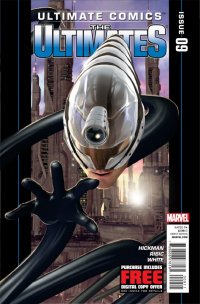
by Graig Kent
I sometimes balk at paying four bucks for a monthly comic, but for the series I like enough I do it anyway. I pay my money and I shut my mouth about how much it costs me, even though, much of the time, I would have been better off financially and story-wise waiting for trade. With the current run of The Ultimates, I’m happily paying my $3.99 month in and month out, so much so that I’d be willing to sink another dollar more (but don’t tell Marvel that, I’m sure they’ll come to collect).
Jonathan Hickman, issue after issue, delivers in this series. Where most of the big two books need to maintain some semblance of status quo and order within their universes, with Hickman at the helm of Earth 1610, everything is chaos. He’s not interested in exploring how heroic or noble one or two characters are, he’s not interested in putting a team through its paces only to have them come out stronger in the end, no, here he’s interested in Earth 1610-shaking-events. He’s taking the idea of superheroes and running with exactly how dominating they would become. It’s in some respects a variation on themes explored by Kurt Busiek in Marvels or Neil Gaiman in Miracleman or Mark Waid in Kingdom Come, but not so pensive as that. He’s delivering incredibly intricate scripts, rife with little gems of ideas throughout that constantly explode into blockbuster action sequences that consistently lead to “holy shit!” moments. Issue number 9 ended with a grandaddy pants-poopy moment, while issue 10 effectively deals with the impact and the ramifications, if somewhat tangentially, but without losing any of the series’ breathtaking momentum.
As perhaps proven by the death of Peter Parker and rise of Miles Morales, the Ultimates universe is a place of change. Can I say there will never be a rebirth of a dead character? Can I say there will never be a retcon of past events? No, of course not. This is comics afterall. But for now, The Ultimates, under Jonathan Hickman is only interested in marching forward.
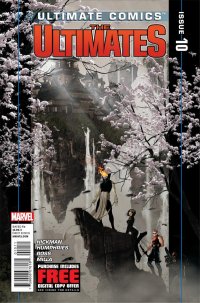 What may challenge the reader most — and we’re talking “western world” comics reader here, reading books produced primarily for American consumption — is that Hickman is so not interested in waving the red, white and blue, chanting “We’re Number 1” and generally thinking that the good ol’ US of A is infallible and indestructible. His story so far, building for the past 10 issues, seems to be putting focus on how far behind the US has fallen while resting on the advancements made in generations prior. Yes, in-story, the proliferation of superheroes within America’s borders once made it strong, but when two new societies appear, almost overnight — one that’s countless generations advanced technologically, and another that’s far superior spiritually and socially — they’re making the Ultimates and the other superheroes in government employ look archaic and feeble. A parallel to the inferiority complex to European scientific advancements as well as perhaps an interpolation of the anxieties over the increasing financial and political pull of China seem to manifest within these pages, but they’re not dwelt upon, there’s far too much else happening within the book’s pages to ponder our sorry state. And yet, it’s there, in the bigger picture, and it’s not Hickman being anti-American (despite what he does at the end of the issue… Libertarians may rejoice), but instead just calling attention to our shortcomings and our weaknesses for the sake of some intense entertainment.
What may challenge the reader most — and we’re talking “western world” comics reader here, reading books produced primarily for American consumption — is that Hickman is so not interested in waving the red, white and blue, chanting “We’re Number 1” and generally thinking that the good ol’ US of A is infallible and indestructible. His story so far, building for the past 10 issues, seems to be putting focus on how far behind the US has fallen while resting on the advancements made in generations prior. Yes, in-story, the proliferation of superheroes within America’s borders once made it strong, but when two new societies appear, almost overnight — one that’s countless generations advanced technologically, and another that’s far superior spiritually and socially — they’re making the Ultimates and the other superheroes in government employ look archaic and feeble. A parallel to the inferiority complex to European scientific advancements as well as perhaps an interpolation of the anxieties over the increasing financial and political pull of China seem to manifest within these pages, but they’re not dwelt upon, there’s far too much else happening within the book’s pages to ponder our sorry state. And yet, it’s there, in the bigger picture, and it’s not Hickman being anti-American (despite what he does at the end of the issue… Libertarians may rejoice), but instead just calling attention to our shortcomings and our weaknesses for the sake of some intense entertainment.
Esad Ribic has been doing an incredible job rendering this oversized story of Hickman’s and he outdoes himself with issue 9. The page four splash is a series highlight, featuring the clash between the people of Tian and the Children of Tomorrow, metas versus mechas. I’m not sure how Ribic manages to capture “epic” in a single panel multiple times in the same issue, but he does, and continues to do so. This series, issue 9 specifically, is huge, and delivers more in 20 pages than most do in half a year’s worth of books.
The perhaps distressing news is it appears Hickman is passing the torch on the series, now co-writing with Sam Humphries, who takes over full bore with issue 13. Humphries made a sizeable splash with the unlikely sci-fi/beastiality indie-hit “Our Love Is Real” last year and showed a keen skill at world building within a small amount of space, yet he’s still quite untested at working on an ongoing and character development so it’s a matter of time to see whether he can find his own light from under Hickman’s shadow. Sadly, with a shift in writer, The Ultimates will no doubt change, and it will be interesting to see whether Humphries carries the thematic undercurrents with him, or has his own designs, and exactly how they shape the Ultimates world.
Art wise, Luke Ross subs in for issue 10 and the next few issues, and while his sensibility more conventional than Ribic, he’s got skill at getting intimate with his characters. It’s kind of the reverse of Ribic’s awe-ispiration, instead of reacting to the scale, you’re drawn more into the emotional intensity.
With two issues remaining in Hickman’s run, given the scale, I expect no resolutions, and no closure to the story Hickman’s been telling, so hopefully, in co-writing with Humphries the transition seems more seamless than jarring, and that, at least some of the concepts and master schemes he was building towards will be fulfilled.
Rating: 




Out of a Possible 5 Stars
Fatale #5 ($3.50, Image)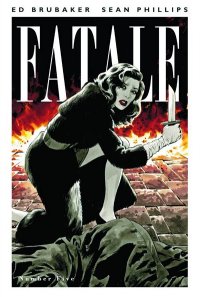
by D.S. Randlett
Chances are you’re reading Fatale. Easily one of the year’s breakout hits (in the middle of a huge year for Image comics), it seems like the comics press is constantly telling me about issues of Fatale going back to print. If anything, it’s been heartening to see such huge leaps taken in recent years to diversify the comics market, and books like Fatale leading the charge.
But I don’t think that this book is working in quite the way that one would hope. Brubaker and Philips are one of the great creative teams in comics, a pairing comparable to Azzarello and Risso, and it’s perfectly reasonable to have high expectations for their work. Certainly, Fatale is a great looking series, featuring some of Sean Philips best work to date. Most of my problems come on the story side, and from a general sense of tone.
Fatale has gotten a lot of press for being a unique combination of noir, of which Brubaker and Philips are probably the reigning champions right now, and horror. Fatale marks a return to fantastic noir for the duo after fare like the more straight edged (and brilliant) Criminal. With Sleeper, the fantastic elements were somewhat in tension with the noir elements, and part of the thrill of that series was seeing the tight rope act. Noir, after all, is about characters in impossibly claustrophobic situations from which there tends to be no escape, whereas superheroes are all about escape and overcoming obstacles. If you have a cast of characters that can overcome the odds, then what could constrain them and make them fear for their lives and hopes? Fear is certainly a primary element in noir, and it certainly makes sense to marry it to horror.
Fatale works as a noir, certainly. It’s characters have desires that push them outside the law, and they’re willing to do what it takes to get it. Brubaker hasn’t lost his touch for well written believable characters or elegant thematic touches, and there are many respects where Fatale shines brilliantly. But it’s just not scary. Brubaker is exploring some interesting ideas about mortality in this series. As the series is incomplete, he hasn’t really unfolded those ideas completely, but watching him do so is always a joy. Still, the horror elements feel like window dressing to this series rather than a key constituent in the unfolding of its themes.
Here we have a Lovecraftian cult that’s wrapped up in a mystery concerning Jo, a seemingly immortal woman who has a strange power over men. The latter is certainly a well-worn noir trope, but what’s interesting here is that it seems that Jo can’t help ensnaring men into her web. She genuinely loves who she loves, and doesn’t want to see them get hurt. Given the circles she runs in, this is pretty much impossible. Her amours, it seems, are all too willing to put it all on the line for her.
As noir, Fatale flat out works. But the book doesn’t really display a good understanding of horror, taking the surface elements of the genre’s Lovecraftian school to establish… what? At this point, Fatale’s “other genre” is there to give the story a macguffin, and excuse for Jo’s immortality. There are cults, tentacle monsters, and gore, but these are only surface elements. Here, horror is a mere aesthetic. What made Lovecraft (an obvious touchstone for this book) great wasn’t that his monsters had tentacles sprouting from their faces, but that his mythos expressed a burgeoning modern fear: that we might not matter. Here, the cultists and the monsters are basically a gang of pretty nasty heavies, when they could represent something far more profound and horrible.
I may seem down on Fatale, but it is a good book and can be downright thrilling in spots. It feels like it could be more, though. At the close of its first arc, Fatale has yet to live up to its true promise.
Rating: 




Out of a Possible 5 Stars
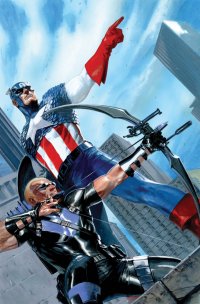 Captain America and Hawkeye #629 (Marvel, $2.99)
Captain America and Hawkeye #629 (Marvel, $2.99)
by Graig Kent
As a child I don’t think I liked any Marvel series more than Marvel Two-In-One, in which every issue the Thing teamed up with a different character in the Marvel Universe. Similarly, from the DC side of things I loved DC Comics Presents, the Superman team-up book, and was crushed when it stopped publishing at issue 97 (they didn’t even push it to 100, the savages). Beyond that, I have a healthy affection for the Brave and the Bold (Batman), and even Marvel Team-Up (Spider-Man), there’s just something about a team-up book that seems like pure comics. There’s usually very little in the way of character development, as the stories were generally plot-driven, although at times, relationship development between the lead and guest was on the menu. A team-up book always guaranteed at least two characters in costume, and one could almost always anticipate a super-villain to be in the mix. Since these series were pretty much one-and-done as the secondary characters cycled through, there was never any story arcs to follow, and often this liberated the writers to take the stories to strange or weird places. As well, you could pick up any issue and get a solid 24 pages of four-color entertainment without having to worry about what came before or after… for the most part.
Team-up books were, in some respects, a clever marketing tool popular in the late 70’s through early 80’s, the team-up heyday, using the lure of premiere characters to expose young impressionable kids to the much larger world of shared universes, in hopes of quickly getting them invested more and more characters. It certainly worked.
I’m not sure that the team-up books were ever top sellers or attention getters (save maybe the legendary DC Comics Presents #47 in which Superman met He-Man, goddamn!) but they were some of the most entertaining books, and it’s great to see them popping their heads up in strange ways as of late, like the Brave and the Bold cartoon, or the oddball Deadpool Team-Up, and now, for the first time, Captain America’s team-up book. At once it seems odd that a character as prominent as Captain America has never had a team-up book (though he has had his share of partners, like Bucky and the Falcon), and yet at the same time, it doesn’t seem like the most natural thing. He’s a figurehead, held up on a pedestal by most characters in the Marvel U, so, you know a Cap/Speedball or a Cap/ROM:Spaceknight team-up just doesn’t seem as right as the Thing pairing up with them. But when you put Cap against the right figure, where there’s some conflict between the character’s points-of-view, or their morals, then there’s something interesting in the meeting.
“Captain America and…” presents a different take on the team-up book of old. For starters, each team-up will be more of a mini-series than a one-off, and instead of launching as an entirely new series, it overtakes the confusingly renumbered Captain America series of old (which had a short run as Captain America and Bucky prior to this issue). As well, the series plans to get more in-depth in the relationship Cap has with his co-star (or sidekick), who gets cover billing for their four issue stint, and in synchronizing with the release of The Avengers major motion picture, it should be no surprise that another star player from the film is the first to tap in.
Written by Cullen Bunn and illustrated by Alessandro Vitti, the series begins by quickly launching into the conflicting attitudes of the featured players. Cap is tactician, a strategist. Though a fighter, he wants to minimize the amount of fighting, and the duration thereof. If a fight can be avoided with his objective achieved, then he’ll choose that route, if not, then he’s going to find the quickest way to end it. Clint Barton, Hawkeye, on the other hand is a shoot-first, why-bother-with-questions-at-
all kind of guy. Impulsive, brash, he’s used to trusting his instincts no matter how often they’ve let him down. Cap respects him as a teammate but not his style, while Clint just seems to like getting the old man’s goat. In this story, the pair, on official Avengers business, stumble across a desert research lab where people are going missing, ultimately to discover its staff aren’t being very forthcoming about what they’re really doing and the dinosaur-human hybrids they may or may not be responsible for seem to be causing them much difficulty.
Bunn picks up on the heroes’ relationship with one another effectively and enjoyably, and introduces a conventional yarn about super-science-gone-wrong, which is fine since it involves human-dinosaur DNA mixing and a potential viral outbreak of dinosaurism (or perhaps I’m just reading too far into things). It’s an enjoyable start, though a little too protracted, as if to pad out the intro to make it last a full four issues. I’m hopeful long-term that the “Captain America and…” winds up being less rigid about its four-issue per structure and gives the stories as much or as little time as they deserve to bring the fun.
Rating: 




Out of a Possible 5 Stars